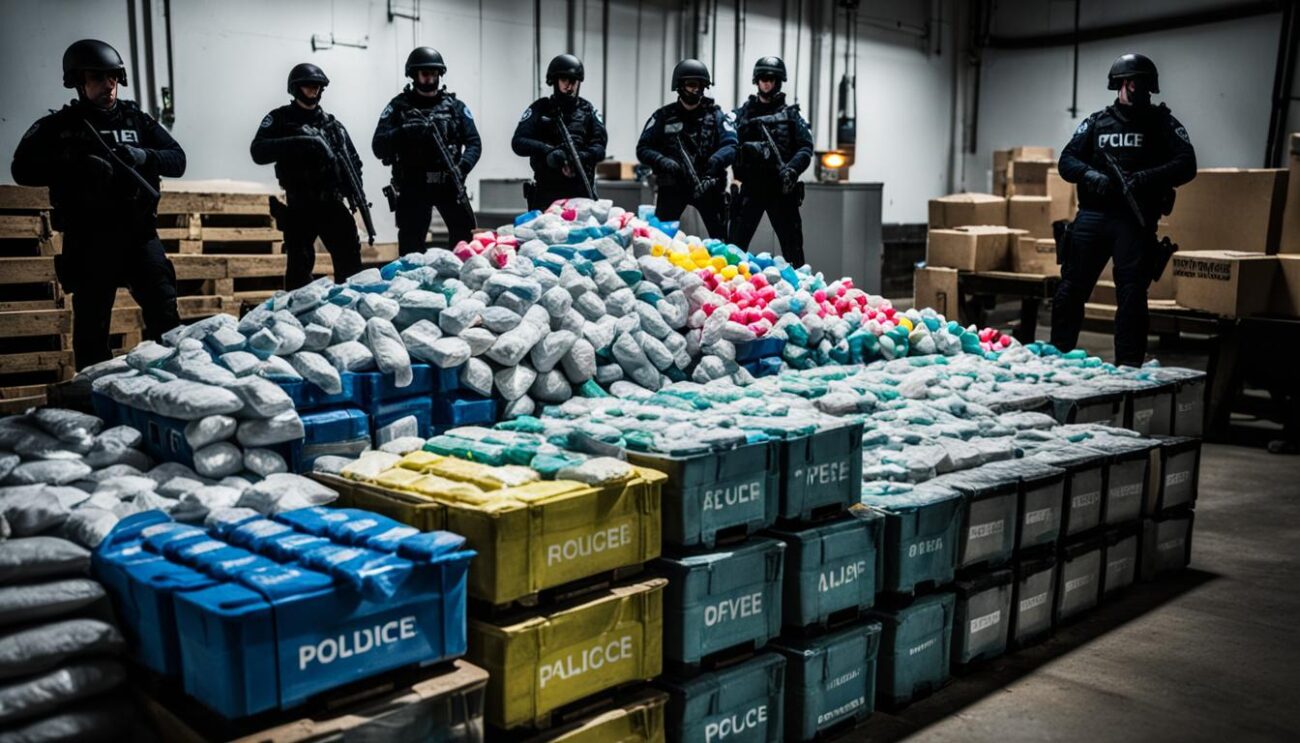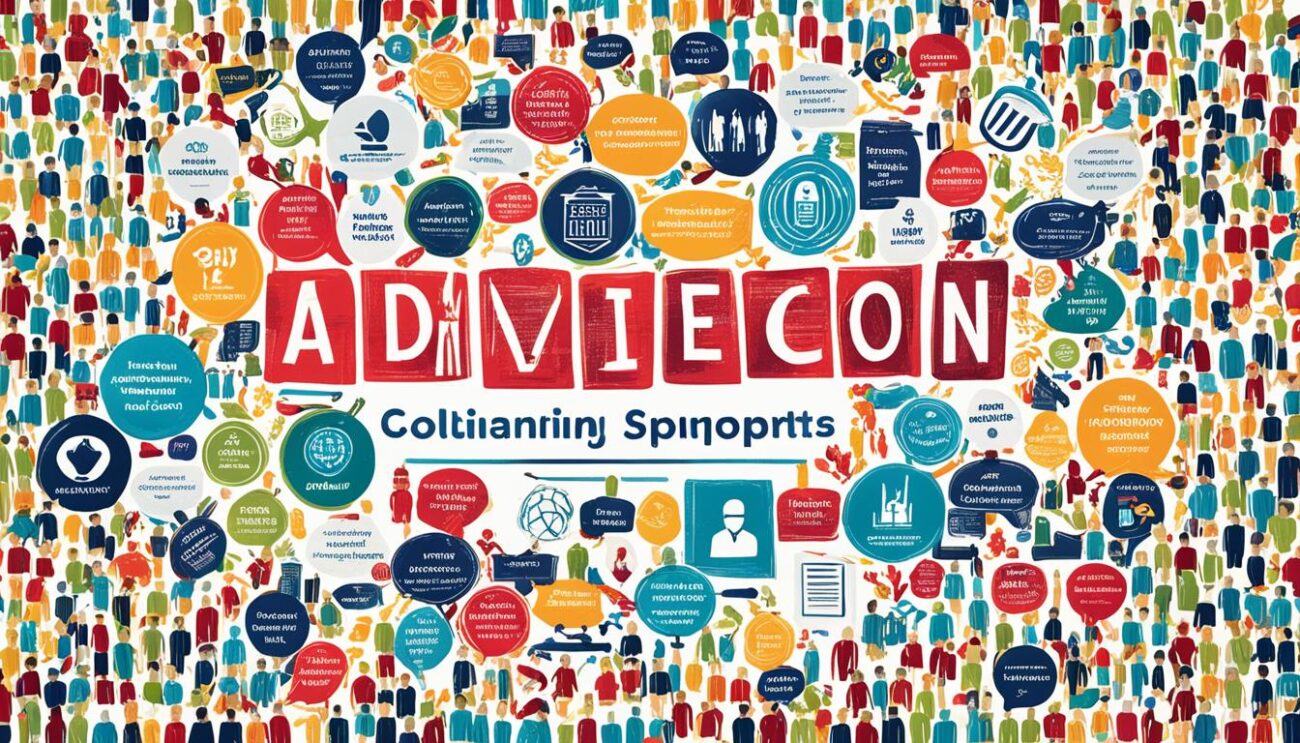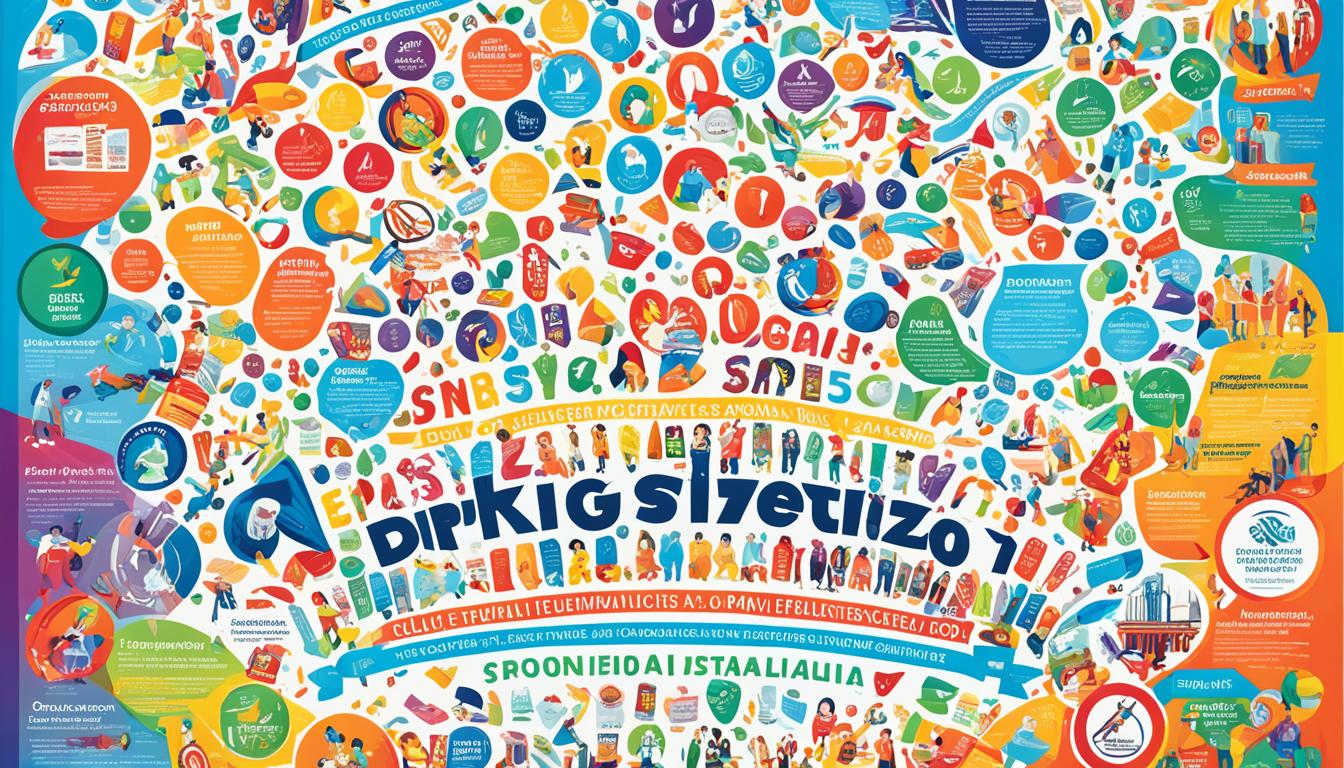drug prevention initiatives in spain
Spain has implemented drug prevention initiatives to combat the use of drugs, alcohol, tobacco and addictive medications. The National Strategy on Addictions 2017-2024 has important goals. It seeks to delay the age of initiation of consumption and reduce drug use.
The strategy seeks a healthier and safer society. To achieve this, collaboration between different entities is encouraged. This includes public administrations, NGOs and research centres.
Drug education programmes and community prevention strategies are key. National anti-drug campaigns are also carried out . These campaigns aim to raise awareness and protect young people and families.
Key Points
- The National Strategy on Addictions 2017-2024 addresses illicit drugs, new psychoactive substances, alcohol, tobacco, medications with addictive potential and behavioural addictions.
- Objectives include delaying the age of initiation of consumption, reducing the availability and prevalence of addictive substances, and reducing associated harm.
- The strategy focuses on achieving a healthier, more informed and safer society by controlling the supply of drugs and addictive activities.
- Drug education programs and community prevention strategies are fundamental to this approach.
- National anti-drug campaigns are carried out to raise awareness among the population and protect young people and families.
National Strategy on Addictions 2017-2024
The National Strategy on Addictions 2017-2024 is a comprehensive plan to address the problem of drug addiction in Spain. It sets clear goals and prevention objectives to reduce drug demand and improve public health.
It will be implemented through two 4-year action plans. These plans will cover different areas of addiction intervention . For more information on prevention and treatment, visit Healthline22.com .
General objectives of the strategy
The main objectives of the National Strategy on Addictions are:
- Achieve a healthier and more well-informed society, reducing the demand for drugs and the prevalence of addictions.
- Achieving a safer society by reducing the supply of drugs and controlling activities that generate addictions.
“Prevention is the best tool to fight addictions and promote a healthier society.” – Government Delegation for the National Plan on Drugs
Areas of action and strategic objectives
The strategy focuses on several key intervention areas :
- Prevention and risk reduction
- Comprehensive and multidisciplinary care
- Harm reduction
- Social integration
- Reduction in supply
- Review of legislation
- Judicial and police cooperation at national and international level
Each area has specific strategic goals and concrete actions to achieve them. For information on treatments, visit Healthline22.com.
| Area of intervention | Strategic objective |
|---|---|
| Prevention and risk reduction | Delay the age of initiation of consumption and reduce the prevalence of drug use |
| Comprehensive and multidisciplinary care | Guarantee quality care tailored to the needs of people with addictions |
| Harm reduction | Reduce the risks and harm associated with drug use |
| Social integration | Facilitate the social and work reintegration of people with addictions |
The National Strategy on Addictions 2017-2024 is an ambitious plan to address the problem of addictions in a comprehensive manner. It establishes clear prevention goals and objectives in different areas of intervention .
Current situation of addictions in Spain
In Spain, there are many information systems and studies that give us current data on addictions. These help us to better understand the prevalence of addictions in Spain , who drug users are , and the social effects of abuse.
Information systems and research studies
Recently, many initiatives have been made to collect and analyze data on addictions. Some examples are:
- The study “Fentanyl in Spain: Evidence, perceptions and realities” carried out by Dr. David Pere Martínez-Oró of Episteme Social, presented on June 19, 2024.
- The 2022 National Drug Plan Report, presented on May 30, 2024, shows the collaboration of several entities.
- The European Online Drug Survey (EWSD) 2024 edition, although it did not provide specific data.
Prevalence of drug use and user profiles
Studies show alarming data on drug use and users in Spain:
| Age group | Regular alcohol consumption | Drunkenness in the last year |
|---|---|---|
| Population over 15 years old | 36.5% | – |
| Young people aged 15 to 24 | – | 36% |
The average age for starting to drink alcohol is 15.2 years. This shows the importance of acting early and well.
Problems related to substance use and their social impact
Substance abuse is a major problem in Spain, causing health, social and economic problems. Some important facts are:
In 2017, 36.5% of people over 15 drink alcohol regularly. Among young people aged 15 to 24, 36% say they have gotten drunk in the last year.
These data show the importance of combating substance abuse with science-based policies and programs.
Institutional framework for drug prevention
Coordination between institutions is key to fighting addictions in Spain. The Government Delegation for the National Plan on Drugs plays an important role. It is responsible for coordinating national drug policy.

The Spanish Council on Drug Dependencies and Other Addictions promotes collaboration between sectors. It seeks to improve policies and actions on illegal drugs and addictions. This council involves several key actors to coordinate drug policies.
The Government Delegation for the National Plan on Drugs coordinates the institutions. It works with the central, regional and local administrations. It is essential for a coherent response to addictions.
Institutional coordination in drug policies requires the active and committed participation of all administrations and entities involved in the prevention, treatment and social reintegration of people with addiction problems.
The Sectoral Conference on Drugs promotes cooperation between the central government and local administrations. This space for dialogue allows for the alignment of efforts and the sharing of good practices. This strengthens institutional coordination in drug policies .
In conclusion, the institutional framework for drug prevention in Spain is based on coordination and collaboration. The Government Delegation for the National Plan on Drugs leads this effort. It is crucial to develop comprehensive policies adapted to the needs of each context.
Guiding principles of prevention policies
The National Strategy on Addictions 2017-2024 sets out key principles for preventive policies in Spain. These focus on evidence, community participation and collaboration between sectors. The aim is to address addictions in a comprehensive and fair manner.
Scientific evidence
Scientific evidence is essential in prevention policies. Programs must be based on rigorous research. This ensures that resources are used effectively to prevent drug use.
Social participation
Community participation is key to the success of preventive policies. The aim is to involve all sectors of society. This allows the development of strategies adapted to the needs of each community and encourages common commitment.
More than 80,000 people, including teachers, families and young people, participated in prevention programs carried out by Proyecto Hombre professionals.
Intersectoral and comprehensive approach
Preventive policies must be intersectoral and comprehensive. This implies collaboration between health, education, social services and justice. In this way, a comprehensive response to the drug problem is offered.
Equity and gender perspective
Gender equity and perspective are fundamental in prevention policies. The aim is to ensure that programs reach everyone, especially the most vulnerable. The differences and needs of men and women with addictions are also considered.
| Organization | People assisted in 2011 |
|---|---|
| Project Man Centers | More than 17,500 people treated for drug-related problems |
| Proyecto Hombre training school | More than 300 students receive training each year in person or online |
| Project Man (total) | More than 1,200 workers and 2,400 volunteers involved in addiction treatment, rehabilitation and prevention services |
These guiding principles, based on evidence, social participation, intersectorality, comprehensiveness, equity and a gender perspective, are essential for effective preventive policies in Spain.
Prevention and risk reduction
It is essential to have prevention and risk reduction programmes to combat drugs in Spain. These programmes aim to delay the onset of drug use and prevent regular use in adolescence. They also seek to reduce the damage caused by problematic use.
In Western Europe, 61 out of 100 people who inject drugs use opioid agonist maintenance treatment. This intervention helps reduce the risk of HIV and hepatitis infections. However, only 17% of people who inject drugs have used needle exchange programmes in the past 12 months.
People who inject drugs in Europe receive, on average, 59 syringes per year through these programmes. These programmes are safe and effective in preventing HIV transmission. However, their coverage and reach need to be expanded.
A study in Spain with female prisoners showed the importance of adapting programmes to their needs. The sample included four profiles of female prisoners:
| Profile | Percentage |
|---|---|
| Ex-addicts | 67.21% |
| Not addicted | 14.75% |
| Addicts in methadone programs | 9.84% |
| Active addicts | 8.20% |
The study, which included 538 valid questionnaires and 61 interviews, found that nearly 70% of women in prison are former addicts. Many do not participate in programs due to lack of information or trust issues. Family pressure is what most motivates them to seek treatment.
The proposed PROSO-MD model seeks to be implemented in the penitentiary setting, adapting to the needs of women, especially former addicts.
These findings highlight the importance of designing prevention and risk reduction programs that consider gender differences and the specific needs of vulnerable populations. Only with a comprehensive and tailored approach can we effectively address the problem of addiction in Spain.
Comprehensive care and multidisciplinary treatment
Addiction treatment requires an approach that combines biological, psychological and social aspects. This means that doctors, psychologists, social workers and educators work together. This way, they offer a comprehensive treatment tailored to each person.
It is key that health and social services work together. This ensures that treatment is continuous and effective. Sharing information and resources helps to provide comprehensive care for each person.
Treatment programs
Treatment programs must be personalized, taking into account the biopsychosocial aspects of each person. They include pharmacological, psychological and social therapies, as well as education and job placement. The choice of multidisciplinary drug addiction treatment depends on several factors.
In Catalonia, since the 1990s, the number of people seeking treatment for cocaine has increased. Cocaine is the second most treated substance. In 2007, a Cocaine Intervention Plan was created with the help of professionals.
Collaboration between health and social services
Coordination between health and social services is key to comprehensive care. Hospitals and health centres should work with day centres and social reintegration programmes. This makes it possible to address all aspects of addiction and support people in their recovery.
A clinical practice guideline on cocaine treatment was created by a group of experts. It offers recommendations based on science and expert consensus. Its aim is to improve care for people with cocaine addiction in Catalonia.
In conclusion, addressing addictions requires a comprehensive and multidisciplinary approach. Coordination between services and professionals is essential to offer quality care. This helps people to recover and reintegrate socially.
Reducing harm associated with consumption
Harm reduction programs are key to reducing the negative effects of drug use. They help prevent diseases such as HIV and hepatitis. One effective strategy is needle exchange programs, which provide sterile material to intravenous drug users.
In addition, safe consumption practices are promoted and condoms are distributed. Naloxone is also used to prevent opioid overdoses. These actions aim to minimize risks and improve the health of users.
In Spain, some cities have supervised consumption rooms . Here, users can use drugs in a safe place with medical care. These rooms not only reduce risks, but also offer access to social and health services.
| City | Supervised consumption room | Start date | Places for intravenous consumption | Places for pulmonary consumption |
|---|---|---|---|---|
| Barcelona | Creu Roja Socio-Sanitary Care and Prevention Service | October 2003 | 2 | – |
| Bilbao | Doctors of the World supervised consumption room | November 2003 | 6 | 6 (since June 2005) |
| Madrid | The Barranquillas | May 2000 – December 2011 | 10 | – |
Worldwide, 15.9 million people inject drugs in 158 countries. More than three million of them are living with HIV. Although 84 countries support harm reduction, access to these programs varies widely.
In many places, criminal laws prevent people from accessing health services. Harm reduction seeks to prioritise the health of drug users, knowing that abstinence is not always possible.
Harm reduction is a pragmatic and compassionate approach that prioritizes the health and well-being of drug users, recognizing that abstinence is not always a realistic or immediate goal for everyone.
Expanding the reach of harm reduction programmes is key, especially in high-risk settings such as prisons. Only ten countries have needle exchange services in prisons. Strengthening these programmes and overcoming legal and social barriers is vital to protecting the health of people who use drugs.
Social integration programs
Social reintegration of drug addicts is key to their recovery and prevention of relapses. T integration programs offer comprehensive support. This helps people with addictions to reintegrate into the community and improve their well-being.
The OEDA 2024 Report in Spain shows the consumption of alcohol, tobacco and illegal drugs. In 2023, 28 million euros were raised for social reintegration programs . These initiatives are essential to address the problems of substance use.
Reintegration into the workforce
The social and labour integration of addicts is essential in these programmes. They offer training and support to find and keep a job. This includes guidance, training, internships and assistance in finding work.
Reintegration into the workforce improves the autonomy and self-esteem of people in recovery. In Spain, programs have been implemented with good results in employment and job stability.
Support for family and social environment
Support for families of addicts is crucial. Families face emotional and practical challenges. Information, counselling and support groups are therefore offered.
Strengthening social support networks is key to reintegration. This involves fostering healthy relationships and providing resources for personal and social development.
| Program | Beneficiaries | Results |
|---|---|---|
| Reintegration into the workforce | 1,500 people | 60% obtained stable employment |
| Support for family members | 3,000 families | 85% reported improvements in family dynamics |
| Mutual support groups | 2,000 participants | 75% maintained long-term abstinence |
In conclusion, social integration programs are vital for the recovery of people with addictions. They promote social integration through job reintegration, support for family members, and strengthening of social networks. This helps prevent relapses and improves quality of life.
Reduction and control of drug supply
Drug supply control policies in Spain aim to reduce illegal drugs. This is achieved through law enforcement and the suppression of drug trafficking . Security forces work together to capture drugs and destroy criminal networks.

The most common drugs in Spain are cannabis, cocaine and heroin. Ingredients for making synthetic drugs are also controlled. International cooperation is key to combating drug trafficking.
| Substance | Amount seized (2020) |
|---|---|
| Cannabis | 1,126,677 kg |
| Cocaine | 37.865 kg |
| Heroin | 233 kg |
The suppression of drug trafficking is a priority in Spain. Work is being done with organisations such as Europol and Interpol. Recent operations have dismantled large criminal networks.
The fight against drug trafficking requires a comprehensive approach. This includes police repression and prevention and demand reduction policies.
Drug supply control policies also seek to regulate medicines containing psychoactive substances. Cooperation with producing countries is encouraged to improve their drug control.
Experts say that reducing supply is not enough. It is important to combine it with demand reduction policies. This includes prevention, treatment and harm reduction. A comprehensive approach is key to tackling the drug problem.
Review of drug legislation
In recent years, there have been debates about legal reforms regarding drugs in Spain. One of the most discussed topics is the decriminalisation of personal consumption of substances, such as cannabis. Currently, the consumption and possession of drugs in public places are administrative offences. This can lead to fines of between 601 and 30,000 euros, according to the 2015 Law on the Protection of Citizen Security.
For minors, the sanction can be suspended if they seek treatment or re-educational activities. The Criminal Code punishes drug trafficking with prison sentences. These sentences vary depending on the substance and the damage to health. There are also aggravating and mitigating circumstances that can change these sentences.
The regulation of “social cannabis clubs” has generated controversy. The Supreme Court has declared that organised cultivation and distribution constitute drug trafficking. This has led to attempts to regulate cannabis at the regional level being declared unconstitutional.
“A serious and rigorous debate on drug policies is needed, based on scientific evidence and respect for human rights, which will allow us to move towards a more effective and less punitive model.”
Some experts and organizations propose a comprehensive review of drug legislation. This should consider:
- The distinction between problematic and non-problematic consumption.
- Prioritising health and social interventions over punitive measures.
- The proportionality of sanctions and their appropriateness to each specific case.
- The need for policies based on scientific evidence and harm reduction.
In short, the debate on legal reforms on drugs is still open in Spain. It is essential to address this issue from a comprehensive perspective. This must take into account the health, social, legal and human rights aspects involved.
Judicial and police cooperation at national and international level
The fight against drug trafficking in Spain relies heavily on police cooperation. The National Police and the Civil Guard work together with local police forces and intelligence services. This has led to major successes, such as the seizure of 11 tons of cocaine in Valencia and Vigo in December 2023.
At the international level, Spain collaborates with Europol and Interpol. This allows for the sharing of information and carrying out joint operations. The anti-drug prosecution service plays a key role in the prosecution of these crimes.
International coordination is key to combating drug trafficking, a global problem. Spain is striving to strengthen collaboration with other countries and international organisations.
Despite efforts, Spain faces challenges in the fight against drug trafficking. According to the Global Organized Crime Index 2023, Spain ranks fifth in Europe. Drug markets, such as cannabis and cocaine, have grown in recent years.
| Type of drug | Score in 2023 | Increase since 2021 |
|---|---|---|
| Cannabis | 7.50 | 0.50 points |
| Cocaine | 7.50 | 0.50 points |
| Synthetic drugs | 5.50 | 1.50 points |
| Heroin | 6.50 | No changes |
To meet this challenge, it is essential to strengthen judicial and police cooperation. Some important measures are:
- Strengthen coordination between security forces and judicial authorities.
- Promote the exchange of information with other countries and organizations.
- Improve the training of agents in the fight against drug trafficking.
- Increase resources to combat these crimes, such as the 36.9 million euros for Andalusia.
In conclusion, police and judicial cooperation are key in the fight against drugs in Spain. Effective international coordination is essential to face this challenge and build a safer and healthier society.
Cross-cutting areas in addiction prevention
Preventing addictions is a major challenge that requires a comprehensive approach. It is key to work together, uniting the efforts of different groups. This helps to create better strategies and make better use of resources.

Coordination between administrations and entities
It is vital that government and third sector organisations work together. This way, they can share information and resources. This avoids duplication of effort and helps to improve joint work.
Knowledge management: information systems, research and training
It’s important to have a good handle on addiction knowledge. This includes creating systems to track progress and see what works. Research helps to know which programs are effective. It’s also key to train professionals so they can better help.
The training of professionals and social agents is a key element to ensure the quality and effectiveness of preventive programs.
International cooperation
Working together with other countries is useful in combating addictions. This allows ideas and solutions to be shared. This is done through joint projects and international agreements.
Communication and dissemination
It is crucial to inform people well about the risks of drugs. This is achieved with educational campaigns and materials. It is important to use various media to reach everyone.
Evaluation and quality of programs
It is vital to evaluate prevention programs. This helps to see what is working well and what is not. This way, improvements can be made and informed decisions can be taken.
| Programs | Target population |
|---|---|
| Key game, Stay Real, Unplugged, Challenges, About canyes and farts, Pase.BCN, THC, what to do?, More than talking about alcohol, 5 top secrets about cannabis, Decideix!, Open your eyes!, Alcohol and other drug prevention program with high school students in the Therapeutic and Educational Unit of the Villabona Penitentiary Center | Adolescents in Compulsory Secondary Education |
| Protecting yourself, Living in the moment?, Don’t smoke, I’m in! | Young people and adolescents in general |
To prevent addictions, it is key to work together and share knowledge. International cooperation, effective communication and program evaluation are essential. This is how we can face this great public health challenge.
Drug prevention initiatives in Spain
In Spain, there are many initiatives to prevent drug use. These range from school programs to information campaigns. The goal is to reduce consumption and addictions.
School programs are essential. They are carried out in schools and seek to delay the start of consumption. They also promote healthy habits among students. Awareness campaigns use the media and social networks to inform about the risks of consumption.
Community interventions and alternative leisure programmes
Community interventions are key in Spain. They involve families, associations and health professionals. Together, they develop strategies adapted to each location. Alternative leisure programmes offer healthy activities to young people, keeping them away from drugs.
Selective and indicated prevention programs for youth at risk
For at-risk youth, there are targeted and selective programs. These target vulnerable groups, such as those from disadvantaged backgrounds. They offer intensive and personalized interventions to strengthen protection and reduce the risk of drug use.




